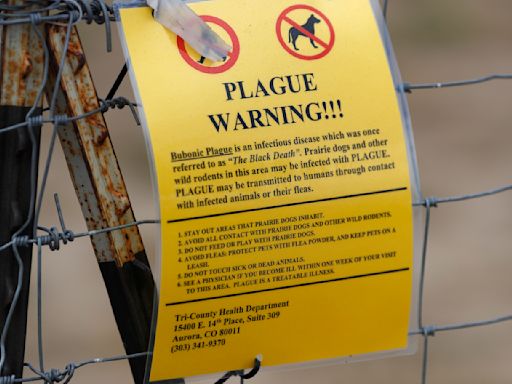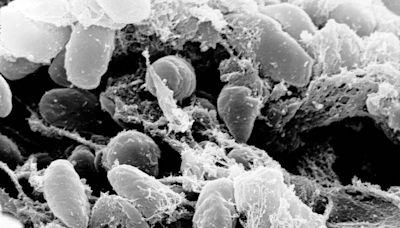Search results
2 days ago · Black Death, pandemic that ravaged Europe between 1347 and 1351, taking a proportionately greater toll of life than any other known epidemic or war up to that time. The Black Death is widely thought to have been the result of plague, caused by infection with the bacterium Yersinia pestis.
- Effects and Significance
Black Death - Plague, Mortality, Europe: It is estimated...
- Cause and Outbreak
Black Death - Bubonic Plague, Europe, 1347: The plague...
- Effects and Significance
The Black Death was a bubonic plague pandemic occurring in Europe from 1346 to 1353. It was one of the most fatal pandemics in human history; as many as 50 million people [2] perished, perhaps 50% of Europe's 14th century population. [3] . The disease is caused by the bacterium Yersinia pestis and spread by fleas and through the air.
- How Did The Black Plague Start?
- Symptoms of The Black Plague
- How Did The Black Death Spread?
- Understanding The Black Death
- How Do You Treat The Black Death?
- Black Plague: God’s Punishment?
- Flagellants
- How Did The Black Death End?
- Does The Black Plague Still Exist?
Even before the “death ships” pulled into port at Messina, many Europeans had heard rumors about a “Great Pestilence” that was carving a deadly path across the trade routes of the Near and Far East. Indeed, in the early 1340s, the disease had struck China, India, Persia, Syriaand Egypt. The plague is thought to have originated in Asia over 2,000 ye...
Europeans were scarcely equipped for the horrible reality of the Black Death. “In men and women alike,” the Italian poet Giovanni Boccaccio wrote, “at the beginning of the malady, certain swellings, either on the groin or under the armpits…waxed to the bigness of a common apple, others to the size of an egg, some more and some less, and these the v...
The Black Death was terrifyingly, indiscriminately contagious: “the mere touching of the clothes,” wrote Boccaccio, “appeared to itself to communicate the malady to the toucher.” The disease was also terrifyingly efficient. People who were perfectly healthy when they went to bed at night could be dead by morning.
Today, scientists understand that the Black Death, now known as the plague, is spread by a bacillus called Yersiniapestis. (The French biologist Alexandre Yersin discovered this germ at the end of the 19th century.) They know that the bacillus travels from person to person through the air, as well as through the bite of infected fleas and rats. Bot...
Physicians relied on crude and unsophisticated techniques such as bloodletting and boil-lancing (practices that were dangerous as well as unsanitary) and superstitious practices such as burning aromatic herbs and bathing in rosewater or vinegar. Meanwhile, in a panic, healthy people did all they could to avoid the sick. Doctors refused to see patie...
Because they did not understand the biology of the disease, many people believed that the Black Death was a kind of divine punishment—retribution for sins against God such as greed, blasphemy, heresy, fornication and worldliness. By this logic, the only way to overcome the plague was to win God’s forgiveness. Some people believed that the way to do...
Some upper-class men joined processions of flagellants that traveled from town to town and engaged in public displays of penance and punishment: They would beat themselves and one another with heavy leather straps studded with sharp pieces of metal while the townspeople looked on. For 33 1/2 days, the flagellants repeated this ritual three times a ...
The plague never really ended and it returned with a vengeance years later. But officials in the port city of Ragusa were able to slow its spread by keeping arriving sailors in isolation until it was clear they were not carrying the disease—creating social distancing that relied on isolation to slow the spread of the disease. The sailors were initi...
The Black Death epidemic had run its course by the early 1350s, but the plague reappeared every few generations for centuries. Modern sanitation and public-health practices have greatly mitigated the impact of the disease but have not eliminated it. While antibiotics are available to treat the Black Death, according to The World Health Organization...
Apr 16, 2020 · Track how the Black Death, also known as the Pestilence and the Plague, ravaged humanity through history.
- John Seven
In October 1347, a ship came from the Crimea and Asia and docked in Messina, Sicily. Aboard the ship were not only sailors but rats. The rats brought with them the Black Death, the bubonic plague. Reports that came to Europe about the disease indicated that 20 million people had died in Asia.
Timeline of significant events during and after the Black Death pandemic, from the arrival of the plague in Europe in 1347 to its subsequent spread throughout the continent over the next four years and the periodic recurrences of the plague in later decades of the 14th century.
Jul 6, 2020 · Plague is one of the deadliest diseases in human history, second only to smallpox. A bacterial infection found mainly in rodents and associated fleas, plague readily leaps to humans in close...





